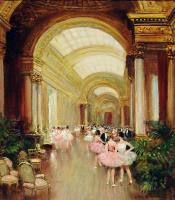
Jules Herve
J.R. Herve, an impressionist of our time, is the very type of artist who has worked primarily on his own, indifferent to the fashion and to outside trends. He has never ceased to deepen the technical secrets of his art. After 50 years of artistic experience, he has arrived at complete mastery of the science of this art which absorbs him. Born in 1887 in Langres, a town in the eastern part of France, he began his art studies in an evening school of his hometown. As far back as he can remember, Herve always wanted to become a talented artist and thus to be able to express the beauty of everything he sees through color.
Herve came to Paris where he first studied at the School of Decorative Arts and then continued at the Fine Arts School. He exhibited his works for the first time at the Salon of French Artists in 1910. Herve was one of the most important members of this group. After obtaining his teaching diploma, he started teaching. From 1911 to 1943 he taught painting to many generations of young artist and in 1914 he received a first silver medal from the Association of French Artists. Shortly thereafter, Herve had to join the army for the duration of the war.
J.R. Herve is both a painter of daily country themes in which there are characters at their daily tasks, and a painter of Parisian scenes. He interprets his scenes with delicate sensibility, putting all his heart into his work. All his artistic sensitivity is achieved by incredible strokes of light and color. Paris, as seen by Herve, is a city of poetry: the ''City of Lights'' under its most touching aspects, and at its most charming. It is a real part of Paris, with its sentimental life, feelings, her special character, that inspired Herve to paint.
Not only is Herve a painter of great talent, he represents the purest tradition of French art. He paints just like the great impressionists of former times, playing with his colors as a musician does with his musical instruments. He obtains in each of his works a marvelous harmony of color and light. His paintings are in numerous museums in France; in the Petit Palais in Pads, at Langres, Troues Dijon, Saint-Etienne, Tourcoing, Annecy and abroad, in the Chicago Museum and at Casablanca.